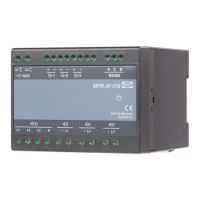MTR-3 Installation Instructions
DEIF A/S Page 27 of 51
Present values
All values are calculated as an average of number of periods set in general settings/average
interval.
Voltage
The instrument measures true RMS values of all phase voltages (U1, U2, U3), connected to the
transducer. Phase-to-phase voltages (U12, U23, U31), average phase voltage (Uf) and average
phase-to-phase voltage (Ua) are calculated from measured phase voltages (U1, U2, U3).
All voltage measurements are available via communication.
Current
Instrument measures true RMS values of phase currents, connected to current inputs. Neutral
current (I
n
), average current (I
a
) and a sum of all phase currents (I
t
) are calculated from phase
currents.
All current measurements are available via communication.
Active, reactive and apparent power
Active power is calculated from instantaneous phase voltages and currents.
Two different principles of reactive power calculation are used:
Standard method:
With this method, a reactive power is calculated based on the assumption that all power which is
not active is reactive.
Q
2
= S
2
– P
2
This also means that all higher harmonics will be measured as reactive power.
Delayed current method:
With this method, reactive power (energy) is calculated by multiplication of voltage samples and
delayed current samples (see chapter 8, “Appendix B: Calculations and equations” on page 36:
Q = U × I|
+90°
With this method, reactive power (energy) only represents the true reactive component of
apparent power (energy).
All measurements are seen via communication. For more detailed information about calculation,
see chapter 8, “Appendix B: Calculations and equations” on page 36.

